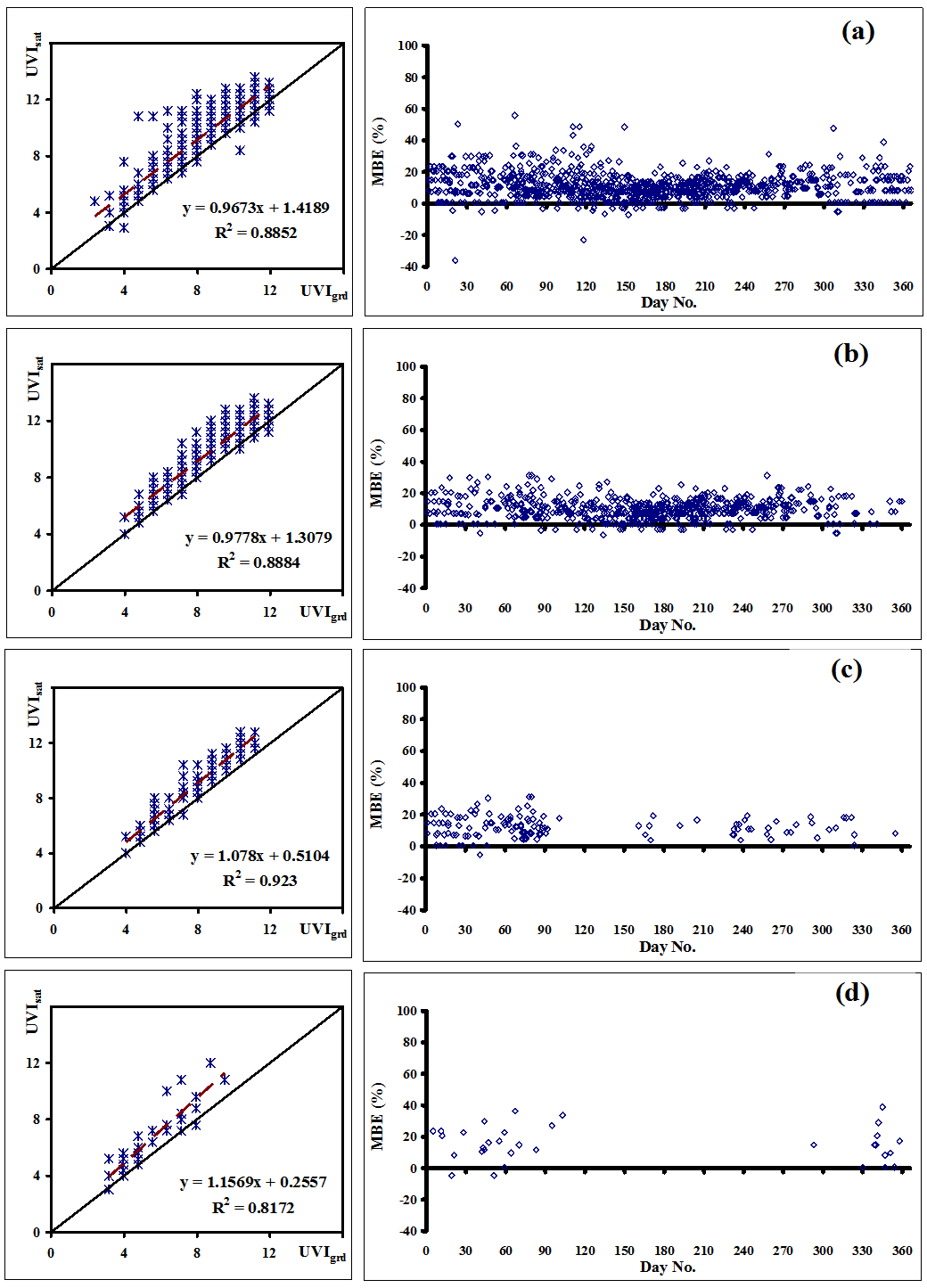| [1] | Huffman Robert E., 1992: Atmospheric Ultraviolet Remote Sensing, Academic Press, Inc. |
| [2] | Parmeggiani L., 1983: Encyclopaedia of occupational health and safety Intemational Labour Of fice, Geneva Switzerland, 2, 1879-1880. |
| [3] | WHO (World Health Organization), 1979: Environmental health criteria 14: Ultraviolet radiation. WHO, Geneva, Switzerland |
| [4] | Foyo-Moreno, I., Vida, J., Alados-Arboledas, L., 1998. Ground based ultraviolet (290–385 nm) and broadband solar radiation measurements in south-eastern Spain. Int. J. Climatol. 18, 1389 -1400 |
| [5] | Matts PJ. 2006: Solar ultraviolet radiation: definitions and terminology. Dermatol Clin.; 24(1), 1-8. |
| [6] | Weatherhead E.C. and Webb A.R., 1997: International response to the challenge of measuring solar ultraviolet radiation, Radiat Prot Dosim., 72(3-4), 223-229. |
| [7] | Arola, A., Kazadzis, S., Krotkov, N., Bais, A., Gröner, J., Herman, J. R., 2005. Assessment of TOMS UV bias due to absorbing aerosols. J. Geophys. Res., 110, D23211, doi:10.1029/2005JD005913. |
| [8] | Tanskanen, A., Lindfors, A., Maatta, A., Krotkov, N., Herman, J., Kaurola, J., Koskela, T., Lakkala, K., Fioletov, V., Bernhard, J., McHenzie, R., Kondo, Y., O’Neill, M., Slaper, H., Den, P., Bais, A. F., Tamminen. J., 2007. Validation of daily erythemal doses from OMI with ground-based UV measurement data. J. Geophys. Res., 112, D24S44, doi:10.1029/2007JD008830. |
| [9] | Cede, A., Luccini, E., Nuñez, L., Piancetini, R. D., Blumthaler, M., Herman, J. R., 2004. TOMS-derived erythemal irradiance versus measurements at stations of Argentine UV Monitoring Network. J. Geophys. Res., 109, D08109, doi:10.1029/2004JD004519. |
| [10] | Chubarova, N. Y., Yurova, A. Y, Krotkov, N., Herman, J. R, Barthia, P. K, 2002. Comparison between ground measurements of broadband ultraviolet irradiance (300 to 380 nm) and total ozone mapping spectrometer ultraviolet estimates at Moscow from 1979 to 2000. Opt. Eng. , 41, 3070–3081. |
| [11] | Fioletov, V. E., Kimlin, M. G., Krotkov, N., McArthur, L. J. B., Kerr, J. B., Wardle, D. I., Herman, J. R., Meltzer, R., Mathews, T. W., Kaurola. J., 2004. UV index climatology over the United States and Canada from ground based and satellite estimates, J. Geo- phys. Res., 109, D22308. doi:10.1029/ 2004JD004820. |
| [12] | Ialongo, I., Casale, G. R., Siani. A. M., 2008. Comparison of total ozone and erythemal UV data from OMI with ground-based measurements at Rome station. Atmos. Chem. Phys., 8, 3283– 3289. doi:10.5194/acp-8-3283-2008. |
| [13] | Kalliskota, S., Kaurola, J., Taalas, P., Herman, J. R., Celarier, E. A., Krotkov, A., 2000. Comparison of daily UV doses estimated from Nimbus 7/TOMS measurements and ground-based spectroradiometric data. J. Geophys. Res., 105(D4), 5059–5067. |
| [14] | Kazantzidis, A., Bais, A. F., Gröbner, J., Herman, J. R., Kazadizis, S., Krotkov, N., Kyrö, E., Den Outer, P. N., Garane, K., Görts, P., Lakkala, K., Meleti, C., Slaper, H., Tax, R. B., Turunen, T, Zerefos, C. S., 2006. Comparison of satellite-derived UV irradiances with ground-based measurements at four European stations. J. Geophys. Res., 111, D13207, doi:10.1029/2005JD006672. |
| [15] | McKenzie, R. L., Seckmeyer, G., Bais, A. F., Kerr, J. B., Madronich, S., 2001. Satellite retrievals of erythemal UV dose compared with groundbased measurements at northern and southern midlatitudes. J. Geophys. Res., 106, 24051–24062. |
| [16] | Meloni, D., Di Sarra, A., Herman, J. R., Monteleone, F., Piacentino, S., 2005. Comparison of ground-based and total ozone mapping spectrometer erythemal UV doses at the Island of Lampedusa in the period 1998–2003: Role of tropospheric aerosols. J. Geophys. Res., 110, D01202, doi:10.1029/2004JD005283. |
| [17] | Sabburg, J., Rives, J. E., Meltzer, R. S., Taylor, T., Schmalzle, G., Zheng, S., Huang, N., Wilson, A., Udelhofen, P. M., 2002. Comparison of corrected daily integrated erythemal data from the U.S. E.PA/UGA network of Brewer spectroradiometer with model and TOMS-inferred data. J. Geophys. Res., 107(D23), 4676, doi:10.1029/2001JD001565. |
| [18] | Weihs, P., Blumthaler, M., Rieder, H. E., Kreuter, A., Simic, S., Laube, W., Schmalwieser, A. W., Wagner, J. E., Tanskanen, A., 2008. Measurements of UV irradiance within the area of one satellite pixel. Atmos. Chem. Phys., 8, 5615–5626, doi:10.5194/acp8-5615-2008. |
| [19] | Antón, M., Cachorro, V. E., Vilaplana, J. M., Krotkov, N. A, Serrano, A., Badarinath, K. V. S., Kharol, S. K., Kaskaoutis, D. G., Kambezidis, H. D., 2007. Influence of atmospheric aerosols on solar spectral irradiance in an urban area. J. of Atmos. and Solar-Terrest. Phys. 69, 589–599. |
| [20] | Palancar, G. G., Toselli, B. M., 2002. Erythemal ultraviolet irradiance in Córdoba, Argentina. Atmos. Env. 36, 287–292. |
| [21] | Nrmeth, P., Toth, Z., Nagy, Z., 1996. Effect of weather conditions on UV-B radiation reaching the earth's surface. Journal of Photochemistry and Photobiology B: Biology, 32, 177-181. |
| [22] | Frederick, J. E., Snell, H. E., 1990. Tropospheric influence on solar ultraviolet radiation: the role of clouds. Journal of Climate, 3, 373–381. |
| [23] | Ilyas, M., Pandy, A., Jaafar, M. S., 2001. Changes to the surface level solar ultraviolet-B radiation due to haze perturbation. J. Atmos. Chem., 40, 111-121. |
| [24] | Kirchhoff, V. W. J. H., Silva, A. A., Costa, C. A., Leme, N. P., Pavao, H. G. Zaratti, F., 2001. UV-B optical thickness observations of the atmosphere. J.Geophys. Res., 106, 2963-2973. |
| [25] | McArthur, L. J. B., Fioletov, V. E., Kerr, J. B., McElroy, C. T., Wardle, D. I., 1999. Derivation of UV-A irradiance from pyranometer measurements. J. Geophys. Res., 104, 30139-30151. |
| [26] | Di Sarra, A., Cacciani, M., Chamard, P., Cornwall, C., DeLuisi, J.J., Di Iorio, T., Disterhoft, P., Fiocco, G., Fua, D., Monteleone, F., 2002. Effects of desert dust and ozone on the ultraviolet irradiance at the Mediterranean island of Lampedusa during PAUR II. J. Geophys. Res., 107 (D18), 8135, doi:1029/2000JD000139. |
| [27] | Kazadzis, S., Bais, A., Arola, A., Krotkov, N., Kouremeti, N., Meleti, C., 2009. Ozone Monitoring Instrument spectral UV irradiance products: comparison with ground based measurements at an urban environment. Atmos. Chem. Phys., 9, 585–594, doi:10.5194/acp-9-585- 2009. |
| [28] | El-Shazly, S. M., Kassem, Kh. O., Hassan. A. A., Eman, F. E., 2012. An Empirical Model to Estimate UV index in Some Upper Egypt Regions. Resources and Environment 2(5): 216-227 DOI: 10.5923/j.re.20120205.05. |
| [29] | El-Shazly, S. M., Mohamed A. M., Abdel-Azeem, M. A, 1995. A statistical study on weather impaction concerning human well-being in the region of Qena, Egypt. Bull. Fac. Sci., Assuit Univ., 24(1-A), P-P. 189-206. |
| [30] | Kassem, Kh.O., El-Shazzly, S.M., Takahashi, M., Adam, M.E.N, 2009. Variability of surface ozone in some regions in Egypt. Ph. D. Thesis, pp 113-114. |
| [31] | Herman, J. R., Bhartia, P. K., Ziemke, J., Ahmad, Z., Larko, D., 1996. UV-B increases (1979–1992) from decreases in total ozone. Geophys .Res. Lett. 23, 2117–2120 |
| [32] | McPeters, R. D., Bhartia, P. K., Krueger, A. J., Herman, J. R., 1998. Earth Probe Total Ozone Mapping Spectrometer (TOMS). Data Products User's Guide. Available at:ftp://toms.gsfc.nasa.gov/pub/eptoms/EARTHPROBE_USERGUIDE.PDF. |
| [33] | McKinlay, A.F., Diffey, B.L. 1987. A reference spectrum for ultraviolet induced erythema in human skin. In Human Exposure to Ultraviolet Radiation: Risks and Regulations; Passchler, W.R., Bosnajokovic, B.F.M., Eds.; Elsevier: Amsterdam, the Netherlands |
| [34] | Fioletov, V. E., Kerr, J. B., Wardle, D. I., Krotkov, N., Herman, J. R., 2002. Comparison of Brewer ultraviolet irradiance measurements with Total Ozone Mapping Spectrometer satellite retrievals. Opt. Eng., 41, 3051-3061. |
| [35] | Torres O., Bhartia P.K., Herman J.R., et al., 1998: Derivation of aerosol properties from satellite measurements of backscattered ultraviolet radiation: theoretical basis. Journal of Geophysical Research, 103, 17,099–17,110. |
| [36] | YES (Yankee Environmental Systems, Inc.), 2008. UVB-1 ultraviolet pyranometer installation and user guide. Available at: ftp://support. yesinc.com /manuals/UVB-1-Manual.pdf. |
| [37] | YES (Yankee Environmental Systems, Inc.), 1997. UVB-1 ultraviolet pyranometer installation and user guide. Version 2.0, pp 3-3 3-4. |
| [38] | Antón, M., Cachorro, V. E., Vilaplana, J. M. Toledano, C., Krotkov, N. A, Arola, A,.Serrano, A., De La Morena, B., 2010. Comparison of UV irradiances from Aura/Ozone Monitoring Instrument (OMI) with Brewer measurements at El Arenosillo (Spain) – Part 1: Analysis of parameter influence. Atmos.Chem. Phys., 10 5979-5989. |
| [39] | NASA (National Aeronautics and Space Administration), 2011. Available at: fttp://toms.gsfc.nasa.gov/pub/eptoms /overpass/. |
| [40] | Bhattarai, B. K., Kjeldstad, B., Thorseth, T. M., Bagheri,. A., 2007. Erythemal dose in Kathmandu, Nepal based on solar UV measurements from multichannel filter radiometer, its deviation from satellite and radiative transfer simulations. Atmos. Res. 85, 112 – 119. |
| [41] | Krotkov, N. A., Bhartia, P. K., Herman, J. R., Fioletov, V., Kerr. J., 1998. Satellite estimation of spectral surface UV irradiance in the presence of tropospheric aerosols: 1. Cloud-free case. J. Geophys. Res., 103(D8), 8779–8793. |
| [42] | Kim J. E., Ryu S. Y. and Kim Y. J., 2008: Determination of radiation amplification factor of atmospheric aerosol from the surface UV irradiance measurement at Gwangju, Korea, Theoretical and Applied Climatology, 91(1-4), 217-228. doi: 10.1007/s00704-006-0285-x. |
| [43] | Hsu, N.C., Herman, J.R., Torres, O., et al., 1999: Comparisons of the TOMS aerosol index with Sun-photometer aerosol optical thickness: results and applications. Journal of Geophysical Research, 104, D6. |
| [44] | Kerr J., Seckmeyer G., Bais A., Blumthaler M., Diaz S., Krotkov N., Lubin D., Madronich S., McKenzie R., Sabzipavar A.A., Verdebout J., 2003: Surface ultraviolet radiation: past, present, and future. Scientific Assessment of Ozone Depletion: 2002, Global Ozone Research and Monitoring Project-Report, 47. World Meteorological Organization, Geneva, Switzerland. Chapter 5. |
| [45] | Silva A. A., 2011: Local cloud cover, ground-based and satellite measurements of erythemal dose rate for an urban, tropical site in Southern Hemisphere, Journal of Atmospheric and Solar-Terrestrial Physics, 73, 2474 –2481. doi:10.1016/j.jastp.2011.09.002. |

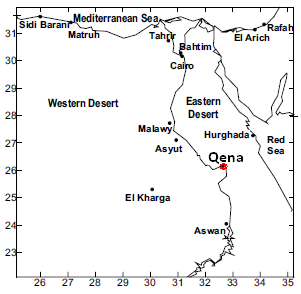






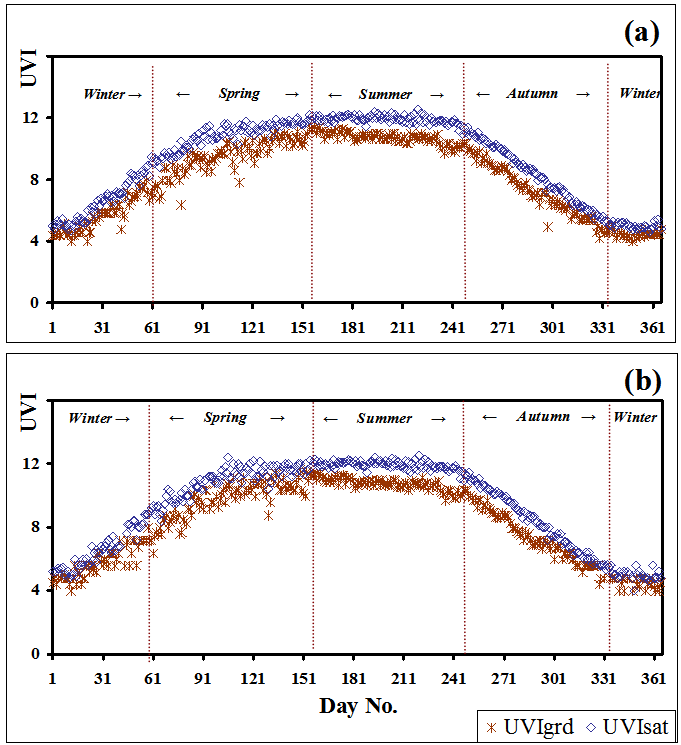
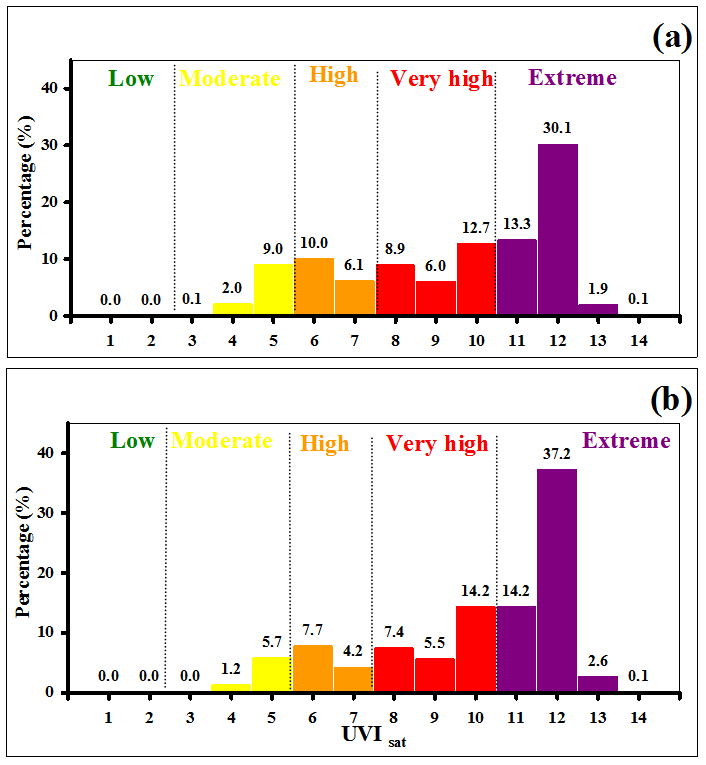
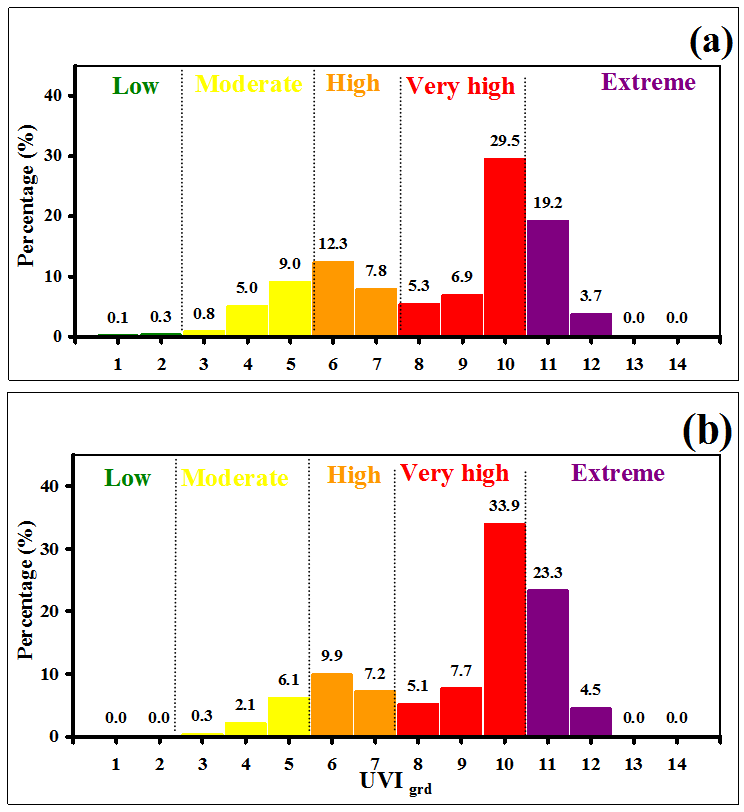



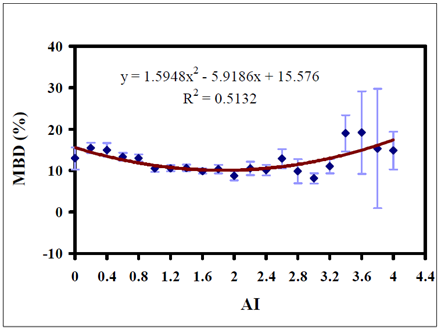



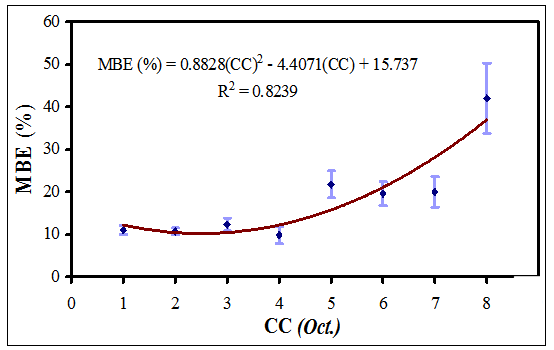
 Abstract
Abstract Reference
Reference Full-Text PDF
Full-Text PDF Full-text HTML
Full-text HTML
